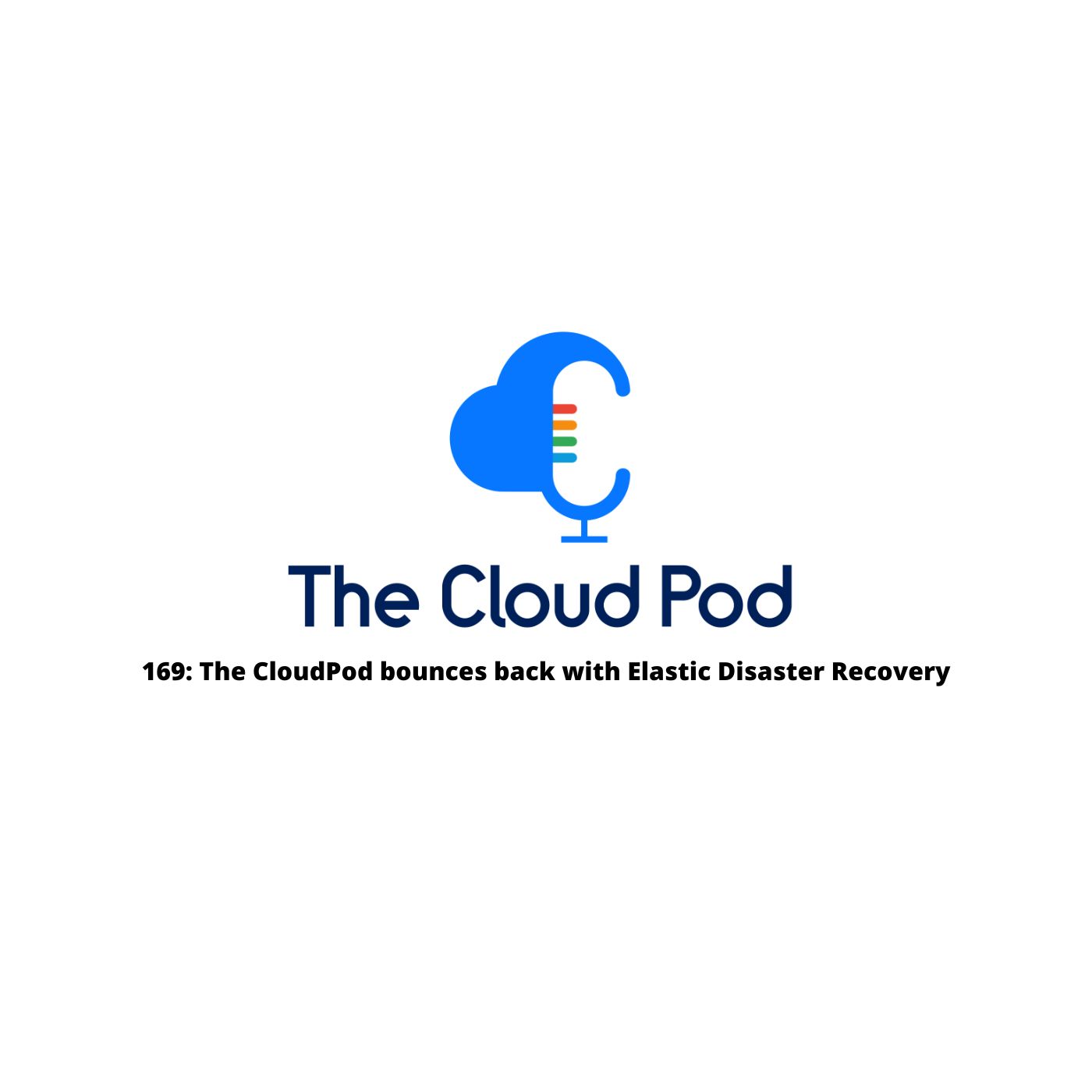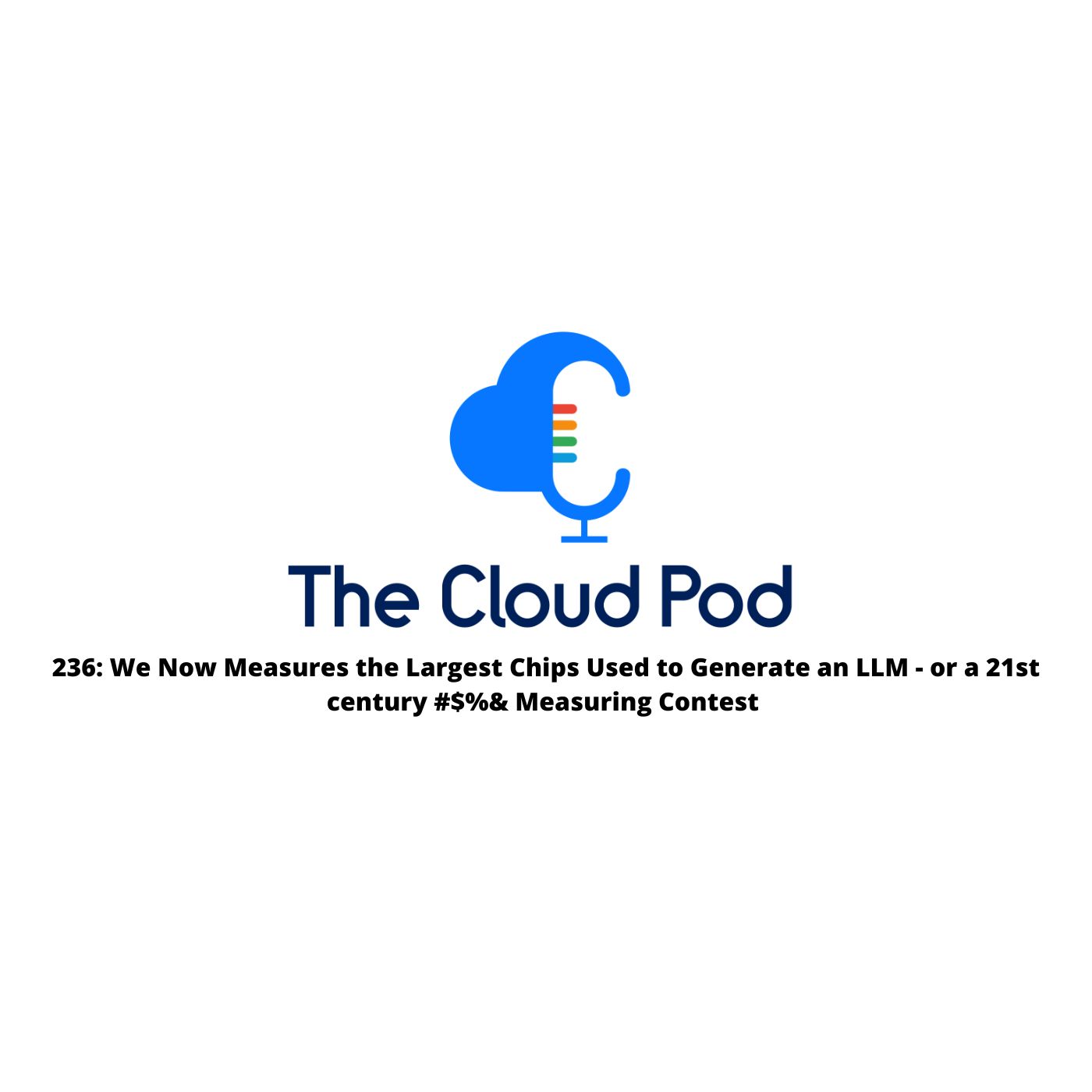Welcome to the newest episode of The Cloud Pod podcast! Justin, Ryan, Jonathan, Matthew and Peter are your hosts this week as we discuss all things cloud and AI,
Titles we almost went with this week:
- The Cloud Pod is better than Bob’s Used Books
- The Cloud Pod sets up AWS notifications for all
- The Cloud Pod is non-differential about privacy in BigQuery
- The Cloud Pod finds Windows Bob
- The Cloud Pod starts preparing for its Azure Emergency today
A big thanks to this week’s sponsor:
Foghorn Consulting, provides top-notch cloud and DevOps engineers to the world’s most innovative companies. Initiatives stalled because you have trouble hiring? Foghorn can be burning down your DevOps and Cloud backlogs as soon as next week.
News this Week:
00:40 - News this week starts out with TCP’s own news - Peter’s podcasting career is riding off into the sunset. He claims he’ll actually start listening, but we’ll see…we’re always happy for more listeners though, no matter how we get them.
02:18 -
FinOps Foundation debuts new specification to ease cloud cost management
- Have we mentioned the FinOps User Conference? I can’t remember if we’ve mentioned that at all… In any event, join the fun June 27th through the 30th in beautiful and sunny San Diego, and be immersed in all things FinOps. It’s a dream vacation opportunity!
- In the meantime, the Finops foundation has announced FOCUS, an open-source initiative designed to help companies more easily track their cloud costs, which will initially launch at the conference.
- The goal of the initiative is to develop a standard specification for organizing cloud spending and usage data.
- According to FinOps, FOCUS will also provide a number of related data management capabilities, MS and Google will join the steering committee tasked with managing the project.
- “FOCUS will solve problems that organizations maturing their cloud adoption now face,” said Udam Dewaraja, the chair of the FinOps Foundation’s FOCUS working group. “Today, there’s no clear way to unify cost and usage data sets across different vendors.”
- FOCUS introduces standardized terminology for describing cloud expenses and usage metrics, provides a standardized schema, or a data format in which financial information can be organized. A schema specifies technical details such as the maximum number of expenses that should be included in each database row.
AWS
04:18
New Storage-Optimized Amazon EC2 I4g Instances: Graviton Processors and AWS Nitro SSDs
- AWS is launching the new I4g instances powered by Graviton2 processors - delivering up to 15% better performance than their storage-optimized instances. Whoo!
- Shapes come in 2 VCPU, 16gb Memory and 468gb of Storage up to 64 vcpu, 512gb of ram, and 15 tb of storage.
- The instances leverage the AWS Nitro SSD’s for NVMe storage. Each storage volume can handle up to 800k random write iops, 1 million random reads, 4600mb/s of sequential writes and 8000mb of sequential reads - more reads and writes than a Scholastic Book Fair!
- “What region is this available?” We hear you asking. Fear not, dear listener! We have that info too. The new features are available in select regions including US-East-1, US-West-2 and Ireland in OD, Spot, RI and Savings Plan Form.
05:08 Ryan - “some of these numbers are just staggering for workloads when, you know, the traditional sort of standard app is hundreds of megabytes maybe like at peak. So this is - it's a lot. I'm glad I don't have to pay for this.”
05:28 Justin - “Yeah, 800,000 random write ops, IOPS. I mean, that's just crazy. And then they can support a million random reads. That's, you know, you'd buy a whole sand just to do that in prior lives. You know, and that'd be your entire workload. Now you're talking about a single server with that kind of throughput. It's just, it's incredible.”
06:06 -
Introducing Bob’s Used Books—a New, Real-World, .NET Sample Application
- For folks who need to support .net apps, up until this point there’s really just been some sample code or a need to go search GitHub for your standardized patterns and methods.
- That is - until now! AWS has a new open-source sample application, a fictitious used book eCommerce store they’re calling “Bob’s Used Books” - a boon for .net developers working AWS.
- The sample app is built using ASP.Net core version 6, and represents an initial modernization of typical on-premises custom applications. Representing the first stage of modernization, the application uses modern cross-platform .net, enabling it to run on Windows and Linux systems in the cloud.
- The .net app is based on a monolithic MVC (Model-view-controller) design. T
- Typical of the .net framework era, it also uses a single MS SQL Server database to contain inventory, shopping cart, user data and more.
- Bob’s Used Books leverages several AWS native services, including Cognito, RDS, S3, AWS SSM, Secrets Manager, Cloudfront and Rekognition
07:12Ryan - “I mean, they want to build a bridge for .NET into the cloud, right? And so they can't start off with stored procedures because it's so hard to make that work in a cloud native environment.”
07:24 Justin - “it would be nice though if they gave you a pattern to, hey, move your stored procedure out of a SQL database and move it into server lists or into some other thing like that. That'd be super nice.”
09:54
New – Set Up Your AWS Notifications in One Place
- Have you ever had to go set up notifications? It’s a lot of clicks through multiple areas of applications. It’s an unnecessary pain. We’re glad to see AWS finally caught up with the other cloud providers in this area.
- AWS is launching AWS User notifications a single place in the AWS Console to setup and view AWS notifications across multiple AWS accounts, Regions and Services
- You can centrally set up and view notifications from over 100 AWS services such as S3, Ec2, Health Dashboard, CLoudwatch Alarms or AWS Support case updates in a consistent, human friendly format. You can also configure delivery channels -- email, chat and push notifications to the AWS console mobile app, where you can receive the notifications.
- Alternatively you can view notifications in the AWS Management Console
11:04Matt - “It looks like from deep in the notes that there's a whole bunch of stuff you have to do in order to get the event bridge events to kind of flow between the accounts. So it doesn't look like it's press a button, get all your accounts in the organization. It looks like it's going to require some setup for multiple accounts.”
GCP
14:05
Chronicle Security Operations Q1 Feature Roundup
- Chronicle has several new features this week to make securing the google cloud easier than ever.
- New Looker Based Advanced Report modules to create strong BI Capabilities and have them completely embedded
- Customers can now grant access to Google Support to help address issues
- New case list view - easier to find those cases raised by Chronicle
- Integration between Chronicle Alerts and Soar
- Enhanced UDM search
- Scheduled Reports - don’t need to log into the console
- Australian listeners rejoice - there's now expanded regional support in Australia for iRap protection. We don’t know what that is. Some sort of murderous Australian spider spray maybe? We assume our Australian listeners know, so we’ll just leave it there.
15:41
BigQuery Differential Privacy
- There are *SO MANY* laws in regards to privacy. And we don’t want to be in charge of that.
- Thankfully, now in Public Preview is BQ differential privacy, which is SQL building blocks that analysts and data scientists can use to anonymize their data. In the future, they will integrate differential privacy with BigQuery data clean rooms to help organizations anonymize and share sensitive data, all while preserving privacy.
- This builds on the Differential Privacy library that is used by the ads data hub and the covid-19 community mobility report.
- They are also partnering with Tumult labs, a leader in differential privacy for companies and government agencies. Tumult labs offers technology and professional services to help google cloud customers with privacy implementations.
- Differential privacy is an anonymization technique that limits the personal information that is revealed by an output. It is commonly used to allow inference and to share data while preventing someone from learning information about an entity in that dataset.
17:27 Peter - “It'll be interesting to see how much easier this makes it. But this has always been a big ask for people moving to the cloud who then want an easy way to have test data and their test environments and other use cases. So if it does make it easier and it's not just a tool that does it on BigQuery, then I can imagine some people are going to be pretty happy.”
Azure
18:04-
Preparing for future health emergencies with Azure HPC
- We’re crossing our fingers that this is a waste of money and that there will NEVER BE another major health emergency. NEVER AGAIN.
- Essentially the GPU’s can be utilized to help prevent that next pandemic.
- Azure HPC enables researchers to unleash the next generation of healthcare breakthroughs. The computational capabilities offered by HPC HB-Series VM, powered by AMD EPYCTM CPU Cores, allows researchers to accelerate insights and advances into genomics, precision medicine and clinical trials, with near infinite high performance bioinformatics infrastructure capabilities.
19:48Jonathan - “I think near infinite high performance is probably a bit of a marketing stretch.”
20:30-
Cloud-based chip design for national security achieves key milestone
- Continued US leadership in emerging technology requires a sustainable supply of advanced chips to power innovation from AI to Quantum computing. The CHIPS and Science act passed last year aims to boost domestic research and manufacturing capacity for critical microelectronics. To support this the DOD launched the Rapid Assured Microelectronics Prototypes using Advanced Commercial Capabilities Program (RAMP), an effort to Accelerate the secure, sustainable development of microelectronics for defense technologies.
- As part of this effort, Azure has developed three new state-of-the-art chips to benefit Azure Government Cloud customers and to ensure compliance with DoD supply chain requirements
- This essentially means the chips can’t be manufactured in China in any way.
Oracle
23:45
Microsoft and Oracle Discussed Sharing AI Servers to Solve Shortage
- Oracle and Microsoft have reportedly discussed an unusual agreement to rent servers from each other if either company runs out of computing power for cloud customers that use large-scale artificial intelligence, according to a person with knowledge.
- The proposed deal discussions have been happening as Oracle Chairman Larry Ellison and other senior executives firm up broader AI strategy, including how to use AI software to improve the company's core software products.
- Who bought a lot of A100 Tensor Core CPUs that are most likely just sitting around? And then who also happens to have a direct connection between their cloud and the other cloud, you know, for things like ordering Oracle databases that could take advantage of selling AI chips to Azure for a profit. We don’t know. Really weird. Ok, moving on.
Continuing our Cloud Journey Series Talks
26:54 We were going to continue with our Cloud Journey Series, but DHH stirred up a bunch of drama, and now we have to address it.
- From the opinionated creator of Ruby on Rails, and Cloud Repatriation, DHH brings us “Amazon can’t even make Microservices or serverless work”
- His latest poke in the eye at cloud computing starts from a pretty innocent post by the Amazon Prime team where they moved from a microservices architecture to a monolith
- DHH basically sums up his entire opinion that microservices are crazy. And that the real word results of all the Microservices “theory” is that in practice, microservices pose perhaps the biggest siren song for needlessly complicating your systems. And Serverless only makes it worse.
- DHH equates Microservices to “Zombie Architecture”. Another strain of intellectual contagion that refuses to die, and has been eating brains since the dark days of J2EE (remote server beans) through the WS-Deathstar Nonsense.
- And he particularly points out that Amazon was the one who started all of this with their huge move to SOA and API calls.
- Is Amazon Eating Crow here?
Scaling up the Prime Video audio/video monitoring service and reducing costs by 90%
- Don’t be confused - it’s really just the microservices of Prime, not Prime itself.
- Going to the source material… what you realize pretty quickly is that this particular thing is not ALL OF AMAZON PRIME.. It's a microservice of Prime. And in this case they deal with big video files and long-running processes.
- They point out that what they built worked, but wasn’t meeting their service SLI/SLO’s and so the re-architecture to a monolith addresses that issue.
- These patterns are all tools and methods, and there is never one correct answer; it depends on many factors. But we all know that microservices should be omnipotent and immutable, and if you break them down too much, you end up in microservice dependency logic hell. Microservice inception sounds like a great idea, right?
30:18 Jonathan - I think the problem they had really is that they took the software architecture and kind of projected that onto the infrastructure services they could use to fill those particular functions in the service they were delivering. I mean, and yes, it worked. And yes, it made sense logically. The diagram is the same regardless of whether it's in a monolith or whether it's user-managed services, but they realized they made a mistake and they need to bring those back to be more tightly coupled again. It makes sense. I mean, there's monoliths and there's monoliths. It's huge monoliths that are manageable. And there's small monoliths like this, which make total sense just as there's microservices deployments, which are completely out of control. It's a huge sliding scale, but to me, this just kind of seems like a little overzealous sort of turning what should be a software architecture into an infrastructure deployment type architecture.”
How to recover from microservices
- If you agree Microservices are the devil and want to stop the insanity DHH gives you 5 tips on how to get back on track:
- Stop Digging - Can’t clean it up if you keep making a mess at the same time
- Consolidate critical, dependent paths first
- Leave isolated performance hotspots for last
- Prioritize dropping the most esoteric implementations
- Learn to partition large systems with modules rather than networks
Monoliths are not dinosaurs
- After DHH’s post went viral, Werner Vogels had to weigh in on his All Things Distributed blog
- He points out that software architecture is not like the architectures of bridges and houses. After a bridge is constructed it is hard, if not impossible to change. Software allows you to make changes and as you evolve the architecture you may change components.
- He highlights how if you hire the best engineers, you should trust them to make the best decisions
- There is not one architectural pattern to rule them all!
33:12 Peter - “Yeah, I want to disagree with David Hansen here, but Ruby on Rails, come on. He made Ruby on Rails. How can I disagree with someone who created Ruby on Rails and raced in the 24 hours of Le Mans?”
35:16 Justin - “we're down to one Ruby on Rails person, which is me, and I'm not even that much of a Ruby on Rails fanboy anymore. I used to be, but I found my way out of that hole, unlike Vader.”
News From the Clouds That Didn’t Make the Main Show
AWS
GCP
Azure
Oracle
Closing
And that is the week in the cloud, we would like to thank our sponsors Foghorn Consulting. Check out our website, the home of The Cloud Pod where you can join our newsletter, slack team, send feedback or ask questions at thecloudpod.net or tweet at us with hashtag #thecloudpod


